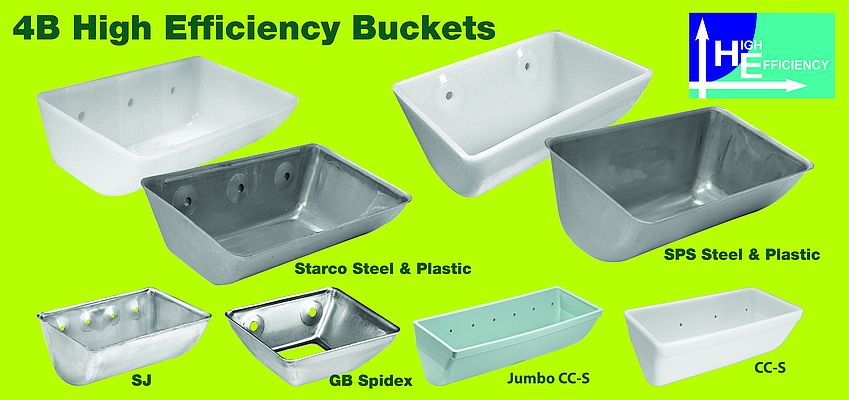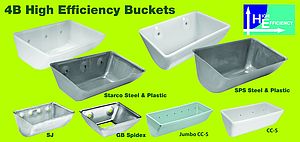Modern high efficiency centrifugal discharge elevator bucket brought the industry greater throughputs and cost savings. Now popular in agricultural applications, they are becoming more widely accepted for industrial use as well.
An elevator bucket is an elevator bucket, right? Not anymore. Recent advances in design technology have brought the advent of the modern high efficiency centrifugal discharge elevator bucket. High efficiency elevator buckets push the traditional limits of carrying capacity, input flow and discharge, construction materials and diminished shipping space.
A high efficiency elevator bucket has all of the following characteristics:
• Smooth interior front faces, with no breaks, that provide an efficient discharge over higher speeds
• They can be mounted closely together to deliver the greatest, and thereby, most efficient throughputl
• A tapered bottom that allows the buckets to fill and discharge efficiently
• The tapered bottom allows the buckets to nest inside one another, for more efficient shipping and storage
• Wing-less sidewalls, making the design more cost efficient and thereby reducing material costs
The “breaks” or “angles” seen in the interior front face of some traditional grain handling elevator buckets serve no determinable function. They neither improve material flow nor discharge efficiency. They simply mimic the design employed by the original fabricated steel buckets of the 1920s, where a break press was used on sheet steel to gradually bend the metal into a curve. High efficiency elevator buckets have a smooth interior front face with employing compound curve geometry. This delivers an efficient discharge with no impediments and no crevices where product can collect. Clean out is efficient and cross contamination is minimized.
High efficiency elevator buckets feature a tapered bottom. This tapered bottom is key to the performance of the high efficiency design and is leveraged for several advantages. It allows the buckets to be mounted closely together with a minimum of vertical spacing. This creates a “column” of input material and generates the greatest amount throughput possible in the elevator leg system.
Close vertical spacing requires the efficient entry and exit of input materials into the elevator bucket string. The tapered bottom allows the buckets to fill and discharge not just from the front, but from the sides as well. This style of bucket feeds more efficiently on the up-leg, but also in the boot section as well.
The tapered bottom allows high efficiency elevator buckets to nest inside one another. This makes shipping and storage more efficient. Traditional buckets do not nest and even when packaged to minimize space, it is mostly air that is being transported. A stack of high efficiency buckets is more dense, and as such, qualifies for the most economical freight rates. Additionally, they use less space in the motor trailer or ocean shipping container, thereby reducing costs even further. Once at the job site, they occupy less floor space for storage.
The “wings” or “ears” found on traditional grain handling elevator buckets do not serve a determinable function either. The origin of the feature is unclear but appears to originate with the first fabricated sheet steel buckets of the 1920s. It may have served as a handle for shop welders to safely grab with their fingers and they tack welded the inside of the buckets together. There is no evidence that the wing provides extra guidance for material during fill or discharge. Buckets cannot nest for shipping and storage if they have this feature. High efficiency elevator buckets do not have wings or ears. Material cost efficiencies are realized with the removal of this physical feature. In some cases, weight savings are realized as well.
The advent of the modern high efficiency centrifugal discharge elevator bucket has brought industry greater throughputs and cost savings. Now popular in agricultural applications, they are becoming more widely accepted for industrial use as well, where over-sized slower moving elevator buckets have been utilized. A true high efficiency elevator bucket has a smooth interior front face, can be mounted closely together, has a tapered bottom, nests inside one another and has no wings on the sidewalls.
Elevator bucket design:
modern versus traditional
- by 4B Braime Elevator Components
- August 27, 2013
- 435 views


















